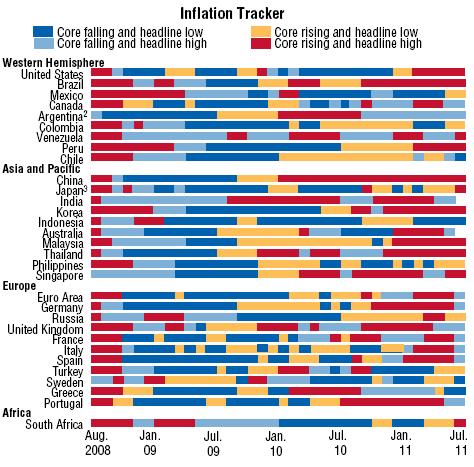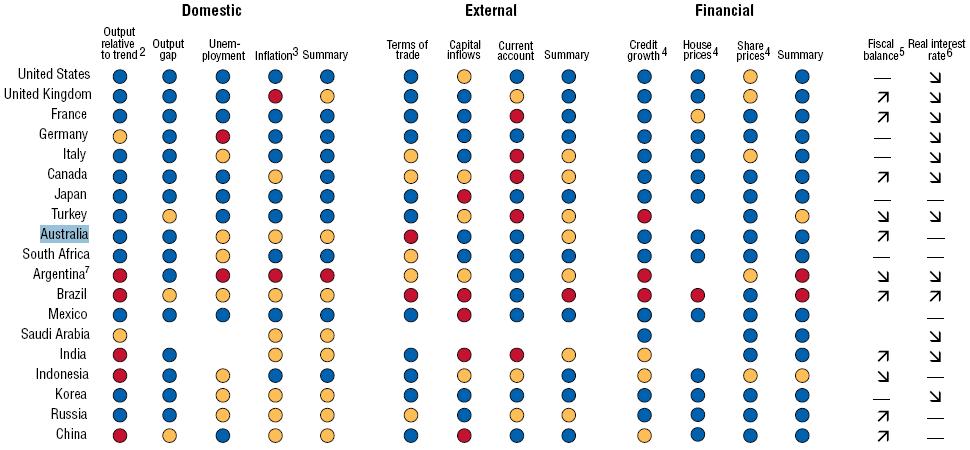I am more used to laughing at IMF prescriptions for solving financial crises than I am used to praising their work, but the latest World Economic Outlook is a breath of fresh air in more ways than one.
It begins with an admission that the last WEO got it all wrong, something a few Australian economists could learn from, not least the bullhawks:
Relative to our previous World Economic Outlook last April, the economic recovery has become much more uncertain. The world economy suffers from the confluence of two adverse developments. The first is a much slower recovery in advanced economies since the beginning of the year, a development we largely failed to perceive as it was happening. The second is a large increase in fiscal and financial uncertainty, which has been particularly pronounced since August. Each of these developments is worrisome—their combination and their interactions more so. Strong policies are urgently needed to improve the outlook and reduce the risks.
Growth, which had been strong in 2010, decreased in 2011. This slowdown did not initially cause too much worry. We had forecast some slowdown, due to the end of the inventory cycle and fiscal consolidation. One-time events, from the earthquake and tsunami in Japan to shocks to the supply of oil, offered plausible explanations for a further slowdown. And the initial U.S. data understated the size of the slowdown itself. Now that the numbers are in, it is clear that more was going on.
What was going on was the stalling of the two rebalancing acts, which we have argued in many previous issues of the World Economic Outlook are needed to deliver “strong, balanced and sustainable” growth.
Bravo and spot on so far as I’m concerned. The WEO then goes on to describe very clearly the problem:
The first leg is fiscal policy. Fiscal consolidation cannot be too fast or it will kill growth. It cannot be too slow or it will kill credibility. The speed must depend on individual country circumstances, but the key continues to be credible medium-term consolidation.
Some countries need substantial outside help to succeed. Going beyond fiscal policy, measures to prop up domestic demand, ranging from continued low interest rates, to increased bank lending, to resolution programs for housing, are also of the essence.
The second leg is financial measures. Fiscal uncertainty will not go away overnight. And even under the most optimistic assumptions, growth in advanced economies will remain low for some time.
During that time, banks have to be made stronger, not only to increase bank lending and baseline growth, but also—and more important—to reduce risks of vicious feedback loops. For a number of banks, especially in Europe, this is likely to require additional capital buffers, either from private or from public sources.
The third leg is external rebalancing. It is hard to see how, even with the policy measures listed above, domestic demand in the United States and other economies hit by the crisis can, by itself, ensure sufficient growth. Thus, exports from the United States and crisis-hit economies must increase, and, by implication, net exports from the rest of the world must decrease. A number of Asian economies, in particular China, have large current account surpluses and have indicated plans to rebalance from foreign to domestic demand. These plans cannot be implemented overnight. But they must be implemented as fast as possible. Only with this global rebalancing can we hope for stronger growth in advanced economies and, by implication, for the rest of the world.
In short, the West must stimulate with a credible longer term deficit reduction plan, the East must dump its mercantilism and banks must be reigned in everywhere. All eminently sane and the opposite of what’s happening. That insanity leads the IMF to hang its forecasts on an unusually gloomy contingency:
Worryingly, various consumer and business confidence indicators in advanced economies have retreated sharply, rather than strengthened as might have been expected in the presence of mostly temporary shocks that are unwinding. Accordingly, the IMF’s Growth Tracker (Figure 1.4, top panel) points to low growth over the near term. WEO projections assume that policymakers keep their commitments and the financial turmoil does not run beyond their control, allowing confidence to return as conditions stabilize. The return to stronger activity in advanced economies will then be delayed rather than derailed by the turmoil. Projections thus point to a modest pickup of activity in advanced economies and robust growth in emerging and developing economies during 2011–12 (Figure 1.5; Table 1.1). Global growth is expected to be about 4 percent. Real GDP growth in the major advanced economies––the United States, euro area, and Japan––is forecast to rise modestly, from about ¾ percent in the first half of 2011 to about 1½ percent in 2012, as the effects of temporary disturbances abate and the fundamental drivers of expansion slowly reassert themselves.
Clearly the IMF is as skeptical as we are at MB that policy-makers can rediscover their mojo.
Onto Australia, and it’s another breath of fresh air with Futureboom! forecasts turfed out in favour what’s really going on. First up, on the growth tracker, Australia gets an insipid if rising range of colours:

And on the inflation tracker there’s some concern, but it is fading beyond the flood effects:

There is also some concern for inflationary impulses from low unemployment:

But, when we turn to the forecasts, that concern too should fade:

The IMF has slashed its April 2011 forecast by 1.2% to 1.8% for this year and for 2012 it cut by 0.2% to 3.3%. Strangely, however, it has not redressed its unemployment forecasts, which are unchanged at 5% for this year and 4.8% for next year. Had it altered those upwards, as it should, lingering inflationary concerns would dissipate.
As Peter Martin pointed out this morning:
The [growth] figure is way below the May budget forecast and only half the most recent Reserve Bank forecast, suggesting it will be harder than expected to reach the promised budget surplus in 2012-13.
I agree with the IMF that Australian growth forecasts at both the RBA and Treasury are miles too high. But there’s a fair argument to make that the IMF is still too high as well. Australian growth this calender year has been zero, with two quarters to go, and the big inventory adjustment in the Q2, it’s a stretch to see growth averaging 0.9% this quarter and next. There’s also the fact that the IMF hasn’t altered its unemployment projections, which is a bit silly at this stage.
The IMF seems to be doing its best to reform its habit of dramatically revising its projections post facto, as it did so painfully in 2008. It has some way to go, I suspect.
Full report below:

